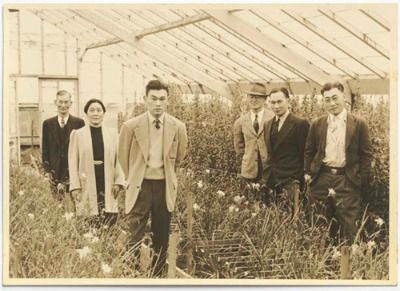Fred Korematsu Joins Civil Rights Heroes in the Portrait Gallery
Two portraits of Fred Korematsu, the face of the Japanese American internment of World War II, have been donated to the National Portrait Gallery
/https://tf-cmsv2-smithsonianmag-media.s3.amazonaws.com/filer/20120410105008korematsu-thumb.jpg)
When Fred Korematsu’s family was forced to leave their home for the Japanese internment camps in 1942, his father hid their family photographs in the rafters of their East Oakland flower nursery. Miraculously, the photographs were still buried in the rafters when the Korematsus returned from the camps three years later. Most families returned to nothing.
Two of these photographs have now made the journey from the flower nursery to the National Portrait Gallery’s “Struggle for Justice” gallery; one shows the Korematsu family in the nursery and the other is a portrait of Fred Korematsu, circa 1940.
“A lot of people ended up burning most of their photographs and their possessions,” says his daughter Karen Korematsu. “They didn’t think they had anything to come back to, especially if they didn’t own land.”
Two of these photographs have now made the journey from the flower nursery to the National Portrait Gallery’s “Struggle for Justice” gallery; one shows the Korematsu family in the nursery and the other is a portrait of Fred Korematsu, circa 1940.
Just a few years later, the serene-looking 20-year-old in the portrait had transformed into a different man. After refusing to obey the executive order that led to the incarceration of 120,000 Japanese Americans during World War II, Korematsu was arrested and sent to prison. He fought his conviction all the way up to the Supreme Court, who ruled that the internment of the Japanese Americans was a “military necessity.” Korematsu spent more than two years in internment camps in California and Utah and was shunned as a troublemaker by the Japanese American community for many years after the war ended.

But when it was discovered in 1983 that the Solicitor General had suppressed evidence that undermined this “military necessity,” Korematsu’s case was reopened and his arrest was voided by a district court in San Francisco. In 1998, he received the Medal of Freedom from President Bill Clinton.
“He believed for almost forty years that we have the ability in this country to come to justice if we’re given the opportunity,” Karen says. “And he never gave up hope. Never.”
Korematsu, who died in 2005 at age 86, is the first Asian American to be commemorated in the civil rights exhibition. Even after his case was overturned, Korematsu lobbied for a formal apology from Congress and reparations to every Japanese American family that had been incarcerated. After that aim was achieved, he joined the fight for the rights of Muslim inmates in Guantanamo Bay, drawing parallels between the Japanese and Arab American experiences.
Karen Korematsu has followed in her father’s footsteps, telling his story to remind younger generations not to repeat history.
“When I cross the country talking about the Japanese American internment, a lot of people still don’t know about this part of history,” she says. “Now I can say, go to the National Portrait Gallery in Washington DC, learn about our history and share it.”
/https://tf-cmsv2-smithsonianmag-media.s3.amazonaws.com/accounts/headshot/ATM-aviva-shen-240.jpg)
/https://tf-cmsv2-smithsonianmag-media.s3.amazonaws.com/accounts/headshot/ATM-aviva-shen-240.jpg)